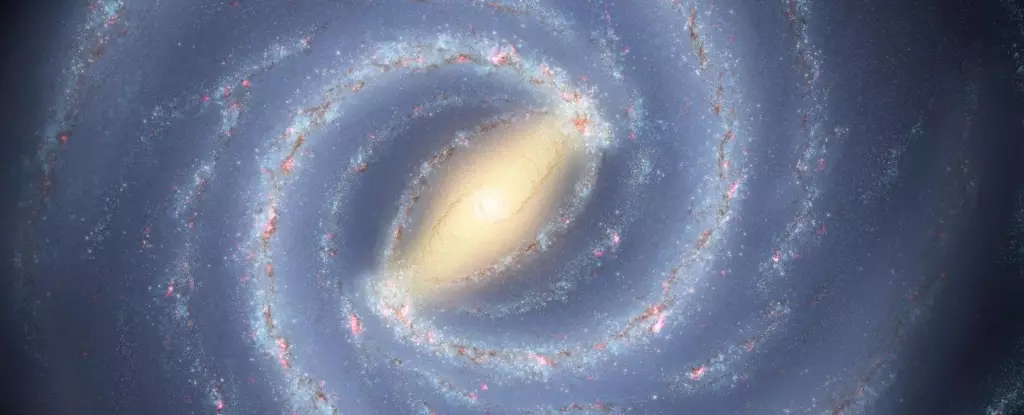The Milky Way galaxy, often likened to a cosmic laboratory, serves as a critical reference point for astronomers seeking to comprehend the formation and evolution of galaxies throughout the universe. This unique position allows scientists to scrutinize our galaxy with unparalleled detail, leveraging advancements in telescopic technology and a multitude of observational techniques. However, a prevailing question among astrophysicists is how much the Milky Way truly reflects the broader characteristics of galaxies. Recent research involving a comparative analysis of 101 galaxies similar in mass to the Milky Way has illuminated some significant distinctions, reframing our understanding of galactic dynamics.
The innovative approach of comparison is grounded in educational techniques that emphasize understanding by juxtaposition. Through well-structured surveys—such as the Sloan Digital Sky Survey (SDSS), the Two Micron All Sky Survey (2MASS), and the European Space Agency’s Gaia mission—astronomers have amassed a wealth of foundational data. Among them, the Satellites Around Galactic Analogs (SAGA) Survey has emerged as a substantial contributor, revealing insights hidden within the cosmos.
The Enigma of Dark Matter
Central to our understanding of galactic formation is the role of dark matter, a mysterious substance that constitutes roughly 85% of the universe’s mass yet eludes direct detection. Astronomers infer its presence from the gravitational effects it exerts on visible matter, underlining its importance in the evolution of galaxies. Research signifies that galaxies typically form within vast halos of dark matter, which attract baryonic matter to fuel the birth of stars and galaxies.
The SAGA Survey focuses on understanding the dynamics of these dark matter halos by examining the low-mass satellite galaxies that orbit larger galactic structures akin to the Milky Way. By cataloging hundreds of satellite galaxies within 101 Milky Way-mass systems, SAGA’s findings reveal that such satellites play a crucial role in elucidating the cosmic interplay at work.
One of the compelling revelations from the SAGA studies is the identification of significant differences between the Milky Way and its galactic peers. Although our galaxy has long served as a standard bearer for models of galaxy formation, investigators emphasized the need to consider a broader range of galaxies for a more comprehensive understanding. Risa Wechsler, a co-founder of the SAGA Survey, stressed this necessity, noting that limiting the investigation solely to the Milky Way poses limitations on our knowledge of galactic dynamics across the universe.
The extensive comparison between the Milky Way and the 101 others noted stark deviations in satellite distributions—some hosting none, while others hosted as many as 13 satellite galaxies. This variance indicates that the Milky Way is an outlier in terms of the number and type of satellites it possesses. The implications of these findings extend far beyond mere numbers, reshaping theoretical models of galaxy formation and evolution.
Active Star Formation in Satellites
One particularly illuminating aspect of these studies revolves around the star formation rates (SFR) in satellites. The SFR serves as a vital metric for understanding how galaxies evolve over time. Within the SAGA Survey’s findings, researchers noted that while star formation remains active among satellite galaxies, proximity to the host galaxy significantly influences their SFR—suggesting that the gravitational pull of the host’s dark matter halo can inhibit star formation in its satellites.
Within the Milky Way, only the Large and Small Magellanic Clouds retain active star formation, underscoring a critical enigma: What factors uniquely affect star formation in the Milky Way’s satellite galaxies, particularly considering its atypical combination of older, quiescent satellites coupled with newly integrated, active ones? This observation not only raises questions about the Milky Way’s distinct environment but also highlights the need for further investigation into the processes at play within its cosmic neighborhood.
As the third SAGA data release reveals new insights, the research community is compelled to dig deeper into the cosmic fabric connecting galaxies across the universe. The innovative models developed from this data hinge on comparative analysis with computer simulations, promising to unlock even greater understanding of stellar mass functions, quenching phenomena, and the role of dark matter on scales smaller than those of the Milky Way.
While the Milky Way may hold a prominent place in our explorations of the cosmos, it is vital not to lose sight of the broader galactic tapestry that awaits us. As the SAGA Survey continues to uncover new facets about galaxies akin to ours, we become better equipped to answer the profound questions regarding not only our galaxy’s uniqueness but also the intricate web of connections that define galaxies throughout the universe. The ongoing frontier of galactic research beckons, promising a deeper understanding of our place within the cosmos.


Leave a Reply